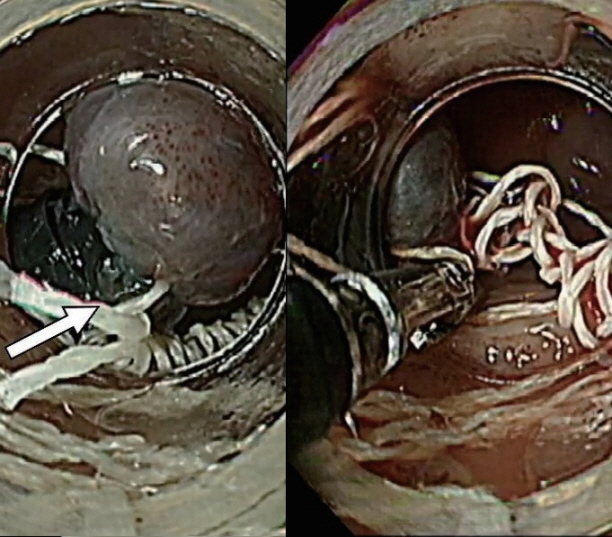Clin Endosc.
2020 Mar;53(2):230-231. 10.5946/ce.2019.076.
Removal of a Trigger Cord Stuck between Bands during Endoscopic Multiple-Band Ligation for Treating Esophageal Variceal Hemorrhage
- Affiliations
-
- 1Department of Gastroenterology, University of Ulsan College of Medicine, Asan Medical Center, Seoul, Korea
- KMID: 2500891
- DOI: http://doi.org/10.5946/ce.2019.076
Abstract
- Endoscopic variceal ligation is the preferred endoscopic treatment method for esophageal variceal bleeding. The incidence of complications such as chest pain, bleeding, stricture formation, and aspiration pneumonia is low. We report a case wherein a malfunctioning multiple-band ligator could have potentially caused damage to the esophageal varices and massive bleeding. The equipment was safely removed using scissors and forceps. To the best of our knowledge, this is the first published report detailing the management of a case of esophageal variceal bleeding.
Figure
Reference
-
1. Garcia-Tsao G, Sanyal AJ, Grace ND, Carey W. Prevention and management of gastroesophageal varices and variceal hemorrhage in cirrhosis. Hepatology. 2007; 46:922–938.
Article2. Hwang JH, Shergill AK, Acosta RD, et al. The role of endoscopy in the management of variceal hemorrhage. Gastrointest Endosc. 2014; 80:221–227.
Article3. Schmitz RJ, Sharma P, Badr AS, Qamar MT, Weston AP. Incidence and management of esophageal stricture formation, ulcer bleeding, perforation, and massive hematoma formation from sclerotherapy versus band ligation. Am J Gastroenterol. 2001; 96:437–441.
Article
- Full Text Links
- Actions
-
Cited
- CITED
-
- Close
- Share
- Similar articles
-
- The Use of Vasoconstrictors in Acute Variceal Bleeding: How Long Is Enough?
- Removal of Esophageal Variceal Bands to Salvage Complete Esophageal Obstruction
- A Case of Esophageal Perforation during Endoscopic Variceal Ligation
- A Case of Obstructive Esophageal Hematoma after Endoscopic Variceal Ligation
- Prophylactic Endoscopic Variceal Ligation for Esophageal Varices with High - risk of Hemorrhage




